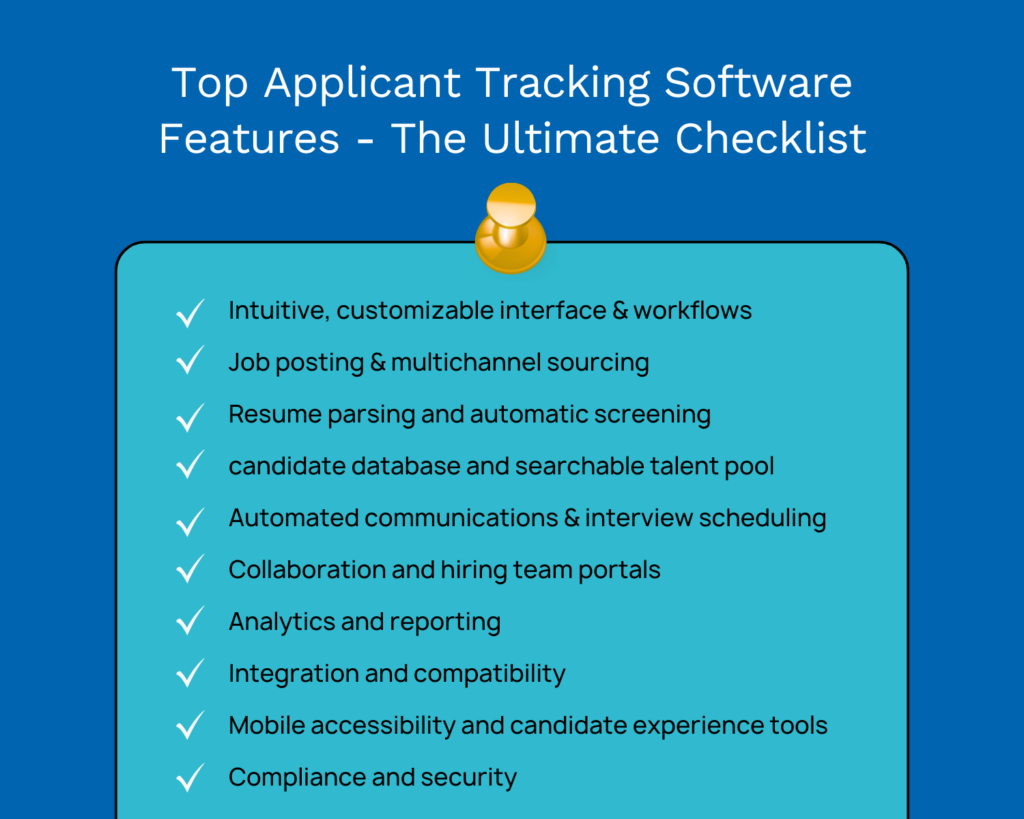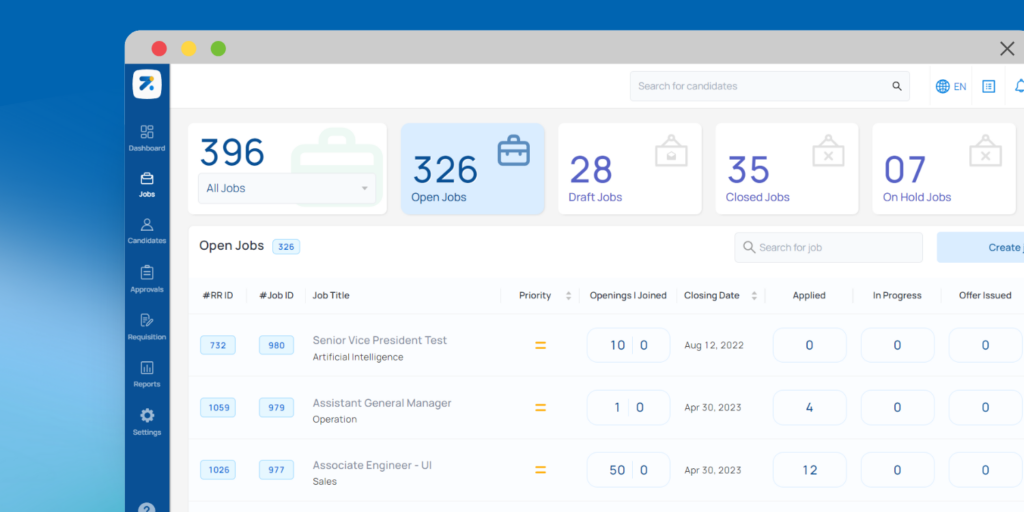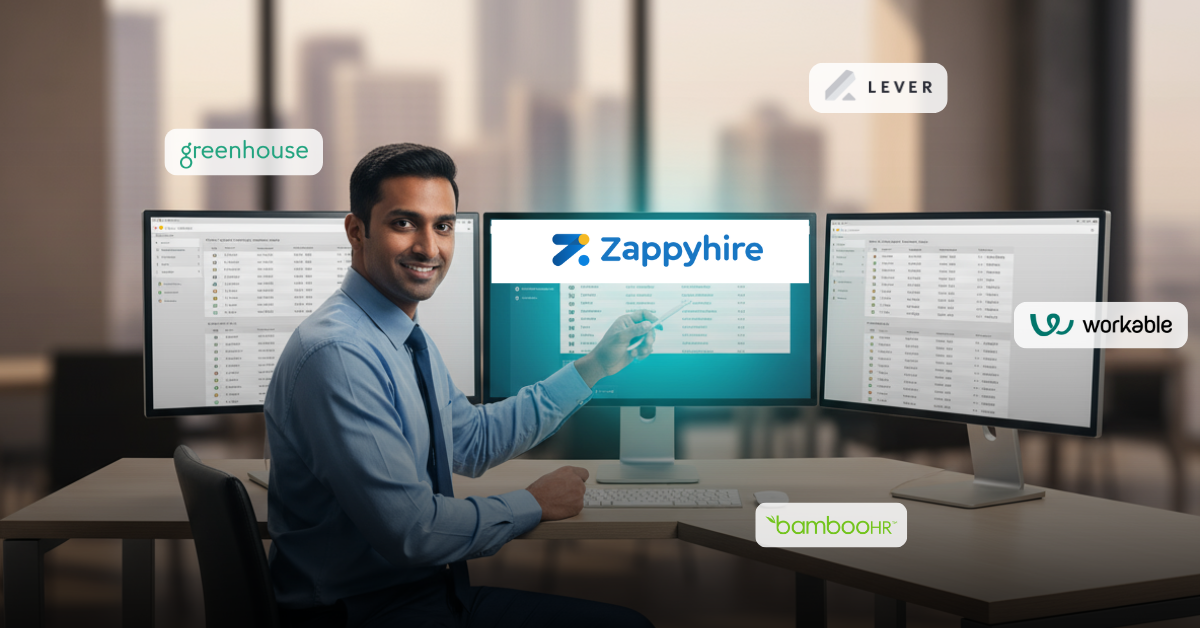A single job posting can attract over 250 applicants on average, yet only a handful get an interview. On top of that, top candidates can vanish from the job market in as little as 10 days, meaning hiring delays can cost you great hires. So recruiters need every advantage to identify top talent quickly.
This is why an Applicant Tracking System (ATS) has become indispensable in modern recruitment. In fact, the majority of companies now use an ATS in their hiring process, including nearly 99% of Fortune 500 corporations.
Recruiters overwhelmingly report that adopting an ATS has streamlined hiring and improved outcomes – 94% say it had a positive impact on hiring efficiency.
But what makes an ATS so powerful? The answer lies in its functionality and the breadth of ATS features it offers.
What is the functionality of an ATS?
An applicant tracking system is a centralized platform to manage and automate the hiring workflow from end to end.
Its core ATS functionality is to track applicants through each stage of the recruitment pipeline while reducing manual effort.
At a high level, an ATS helps HR and hiring teams stay organized, find more qualified candidates faster, and create a better candidate experience.
How does it achieve this?
The applicant tracking software stores all candidate information, tracks each applicant’s status, and automates time-consuming tasks like resume screening, interview scheduling, and sending notifications.
It acts as an electronic gatekeeper and facilitator as it can automatically filter and rank incoming resumes based on keywords or criteria, ensuring recruiters focus on the most promising candidates.
It also keeps a log of every touchpoint (applications, emails, interviews, feedback), so nothing falls through the cracks.
In practical terms, an ATS software with smart features can post job openings to multiple job boards in one click and accept applications via an online portal or email parsing – both key features of applicant tracking systems.
As applications come in, resumes are automatically parsed into structured, searchable formats using keywords or filters (like skills or experience).
Recruiters can then search the database or apply auto-shortlisting rules. The ATS also tracks every candidate’s journey – application, screening, interviews, offers – providing full visibility into hiring progress.
What are the key features to look for in an ATS?
Not all systems offer the same depth of ATS functionality. When evaluating applicant tracking systems for enterprise hiring, it’s important to assess the key features and capabilities that will drive results.
Below is an applicant tracking system feature list of essential features (and why they matter) that recruiters, CHROs, and hiring leaders should look for.

Intuitive, customizable interface & workflows
A user-friendly ATS is important for adoption across your team. Look for an interface that is clean and easy to navigate, with a configurable workflow that adapts to your hiring process (e.g. ability to add custom stages, approvals, or templates).
The system should let you tailor pipelines for different roles or departments. This flexibility ensures the ATS supports your unique processes rather than forcing you into a one-size-fits-all funnel.
Job posting & multichannel sourcing
One of the foundational ATS features is the ability to post jobs to multiple channels effortlessly.
A good system will integrate with major job boards, career sites, and social media platforms so you can publish a new job opening everywhere with a single submission. This feature expands your reach to attract more candidates without extra effort.
Plus, the ATS should offer a branded career page or portal integration, presenting your employer brand consistently and making it easy for candidates to find and apply to your jobs. This feature ensures you have a broad and organized talent funnel from the start by centralizing job posting and inbound applications.
Resume parsing and automatic screening
Manually sifting through hundreds of resumes is unsustainable. Advanced ATS software with smart features includes a robust intelligent resume parser to automatically extract candidate details (contact info, experience, skills, education, etc.) and load them into a structured candidate profile.
For example, you might configure the system to flag candidates who meet certain criteria (keywords, years of experience, certifications) or to automatically disqualify those who don’t meet basic requirements (using “knockout” questions or filters).
These ATS functions dramatically reduce the time recruiters spend reading resumes by surfacing the best matches first.
However, a balanced approach is needed as the system should allow fine-tuning to avoid filtering out great candidates due to overly rigid criteria. The goal is to let the ATS do the heavy lifting of initial resume review, so recruiters can focus on a qualified shortlist.
Candidate database and searchable talent pool
Over time, your ATS will accumulate a goldmine of candidate data. Ensure the system has powerful search capabilities to mine this talent pool.
This includes keyword search (with support for Boolean queries), filters for attributes like location, skills, or past interview feedback, and even semantic search or AI recommendations.
Strong search functionality means recruiters can quickly rediscover past applicants or silver-medalist candidates for new roles – a huge time saver.
All candidate interactions (emails, interview notes, status updates) should be logged in one profile so that anyone on the team can pick up the conversation without friction or searching through multiple databases/sheets.
Think of this feature as a CRM for candidates; it builds a proprietary database of talent that you can tap into anytime, rather than starting every search from scratch.
Automated communications & interview scheduling
Effective recruiting requires timely communication, and an ATS should enable this. Look for features like email templates and automated messaging that can send personalized updates at scale. For instance, confirming application receipt, sending interview invitations, or rejection notes.
This ensures no candidate is left in the dark, which improves your employer brand.
Choosing an ATS platform that can integrate with calendar systems (e.g. Outlook or Google Calendar) for automated interview scheduling is crucial.
This helps in eliminating the back-and-forth emails to find a time slot and empowers candidates to schedule interviews at their convenience.
| 🔖 Recommended Article – Top 10 Applicant Tracking System (ATS) in India for 2025 |
Collaboration and hiring team portals
Another key feature to look for in an applicant tracking software is the ability to easily collaborate between different hiring managers and stakeholders in the interview process.
The platform should have the ability to share candidate profiles with hiring managers (often via dedicated hiring manager logins or portals), collect structured feedback and ratings, and manage permissions/roles so each stakeholder sees the right information.
For example, a hiring manager should be able to log in to review candidates for their open role and leave interview feedback in the system, while an HR administrator can oversee the process without micromanaging emails.
An ATS should ensure everyone stays on the same page by centralizing feedback and communication among recruiters, hiring managers, and even interview panelists. This speeds up decision-making and provides transparency – no more lost emails or verbal feedback that isn’t recorded.
Analytics and reporting
Data-driven hiring is a priority for today’s talent leaders, especially at the enterprise level.
A strong ATS will offer analytics dashboards and customizable reports to track key hiring metrics.
Key hiring metrics include time-to-fill, time-to-hire, source of hire, candidate drop-off rates, diversity metrics, and quality-of-hire indicators.
These insights let you identify bottlenecks (e.g. a particular stage where candidates withdraw), measure ROI of your recruitments, and continually improve your process.
When evaluating ATS options, ask to see their standard reports and whether you can create custom reports or export data easily.
For a CHRO or talent acquisition leader, reporting features provide hard data to justify hiring strategies and budgets.
Integration and compatibility
In an enterprise environment, an ATS rarely stands alone. You’ll want a system that integrates smoothly with your existing HR tech stack.
At minimum, look for integration options (native or via API) for HRIS/HRMS systems, payroll and onboarding software, background check and assessment tools, video interview platforms, and single sign-on (SSO) for security.
For example, when you hire a candidate, the ATS should be able to send their data to your HRIS to kick off onboarding without manual data entry. Or if you use assessment tests, the ATS should let you trigger those and receive results in the candidate’s profile.
A well-integrated applicant tracking system eliminates data silos and duplicate work. It also future-proofs your investment – as your company adopts new tools, your ATS should be able to connect or adapt. Be sure to inquire about an ATS’s API, available integrations, and any additional costs involved.
In short, ATS software with smart integration features will play nicely in your broader ecosystem, which is vital for enterprise deployment.
Mobile accessibility and candidate experience tools
Considering that more than half of job applications now happen on mobile devices, it’s critical that both candidates and recruiters have a mobile-friendly experience.
From the candidate side, the ATS should support a responsive career site, mobile application forms, and even chatbots or texting features to engage candidates on the go.
Many modern systems offer companion mobile apps or at least a mobile-responsive web interface.
Additionally, advanced candidate experience features are a big plus: think conversational recruiting chatbots that guide applicants, automated status updates that keep candidates informed, and automated interview scheduling to prevent scheduling conflicts.
A positive candidate experience isn’t just about being nice and having a pleasant conversation – it directly impacts hiring success. Research shows that a poor recruitment experience leads a majority of candidates to decline job offers (even more than compensation issues).
Therefore, an ATS that helps you deliver a seamless, engaging experience will ultimately help you secure better talent.
Compliance and security
Enterprise recruiters must navigate legal and security considerations.
The right applicant tracking system supports compliance with hiring regulations – for example, tracking EEO/OFCCP data in the U.S., GDPR compliance in the EU (such as managing candidate consent and data retention), and providing accessible application processes to meet disability standards.
Look for features like audit trails (so you can see who made what changes when), role-based access control to protect sensitive data, and data encryption/security certifications to ensure your candidate data is safe.
Compliance reporting (e.g. the ability to quickly pull reports for an OFCCP audit) can be a lifesaver.
Also, if diversity hiring is a focus, an ATS can help by anonymizing resumes for blind recruitment/screening or providing diversity analytics.
Choosing an ATS with strong compliance features gives peace of mind that as you scale hiring, you won’t run into legal troubles or security breaches. It also ensures fairness and consistency in how candidates are treated.
Zappyhire – An ATS with smart, customizable features
To illustrate how these features come together in a modern platform, let’s look at Zappyhire – an ATS software with smart features and highly customizable options. Zappyhire is an AI-powered recruitment automation platform designed for enterprise hiring needs.

Human-centric and configurable design
Zappyhire offers a user-friendly, drag-and-drop interface for building hiring workflows, enabling recruiting teams to customize stages and rules without needing technical support – ideal for organizations with unique hiring steps or compliance requirements.
Smart ATS features powered by AI
Zappyhire uses advanced AI and automation to enhance efficiency and talent outcomes, featuring capabilities like AI résumé screening and auto-ranking of candidates, automated interview scheduling (including AI video interviews), and a cognitive recruiting chatbot that interacts with candidates and conducts initial assessments.
Beyond basic applicant tracking
Zappyhire acts as a comprehensive recruiting co-pilot, not just tracking applicants but automating repetitive tasks, offering smart hiring recommendations, and elevating the experience for both recruiters and candidates.
Enterprise-ready scalability and security
Built for large-scale deployment, Zappyhire supports thousands of users and integrates seamlessly with existing HR systems, ensuring it meets the security, scalability, and integration needs of enterprise organizations.
Ideal for future-focused hiring
With its blend of customization, automation, and AI-driven intelligence, Zappyhire exemplifies the new generation of ATS platforms that forward-thinking companies are adopting to sharpen their hiring edge.






